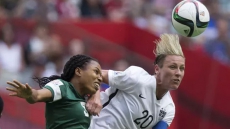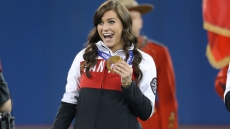TORONTO — A pair of Ontario college students is facing a tough crowd as they try to design an audible hockey puck that can be used by visually impaired players.
And the international judges vetting the product at a global engineering contest this weekend won't even be the harshest critics.
Those would be the players themselves, who say people have been designing pucks containing electronic noisemakers for decades and haven't yet managed to create one that works well on the ice.
They say it's proven difficult to find a puck that can be heard equally well while stationary or in motion, adding that ice temperatures and arena acoustics add further challenges.
The Sheridan College classmates, however, say those very issues prompted them to redesign their puck three times in the last five months. They believe they've now come up with something that will distinguish them at the IAM3D challenge taking place in Boston on Sunday.
The audible hockey puck is among 20 finalists for this year's competition and will be up against three other entries from fellow Sheridan students.
The team behind the project may seem an unlikely choice to spearhead the latest effort to develop a puck.
Ryan Vieira said he and his fellow student Kristoffer Pascual, who are both fully sighted, had little interest or familiarity with hockey when they took on the project. Nor were they influenced by the myriad previous designs that had fallen in and out of favour for at least the past 40 years.
"I was always into it for the challenge," the 23-year-old said in a telephone interview. "I had no design to work off. I was just given a basic shape and what it had to do."
But requirements for the puck proved more complex than the team had anticipated, something previous other designers had learned the hard way.
Matt Morrow, executive director with Courage Canada — the blind hockey promotional organization — said sound is merely one factor.
The finished product needs to be both bigger and slower than a standard-issue puck, Morrow said, so that players with a variety of different vision levels can play. Materials also need to be pliable in order to minimize injuries, while still being durable enough to withstand blistering passes and hard impact with boards and goal posts.
And the sound the puck emits has to work whether it's traveling down the ice, soaring through the air or at rest on the blue line.
"No electronic puck has ever worked," Morrow said.
The original blind hockey puck, debuted in Montreal, was nothing more than a 1.4-litre apple juice can that was painted black for the benefit of those with some functional vision. That model proved cumbersome, since the cans would dent easily and had to be replaced up to eight times a game.
Different models have come and gone since then, with each of Canada's three established visually impaired teams using different pucks at one point. Toronto's Ice Owls, for instance, once played the game using a hollowed-out wheel from a barbecue filled with piano pins and ball bearings.
Wayne St. Denis, who has played on the team since 1996, said the design stayed in use for years, despite the fact that the bearings stopped rattling the moment the puck came to rest, making it difficult for totally blind or extremely low-vision players to locate it and resume play.
The puck needs to make a constant sound, St. Denis points out, adding that many electronic tones are not necessarily viable thanks to the complex acoustics inside an arena.
"Sometimes even if the puck is in front of you, it sounds like it's to the left or the right of you because of the reflection of the noise," he said. "That's a tricky one."
Vieira and Pascual also found percussive shots and the hiss of skates on the ice were often enough to obscure the sound of buzzers or beeps.
Their solution, Vieira said, wasn't as simple as pumping up the volume.
"We're trying to go for a piercing noise that you can hear through the normal play instead of just trying to compete with volume," he said. "To compete with volume, you'll just never be able to pack enough power into the puck to project enough noise to be louder than a normal game and still keep the puck below weight."
Vieira and Pascual had to go through two prototypes before settling on the design they'll present in Boston. Previous incarnations were made of plastic that grew too brittle when exposed to the ice, contained circuit boards that fell apart upon impact with a stick, or featured speakers that didn't project sound out towards the players and were also susceptible to damage during play.
The final product, produced in the 3D printing lab at Sheridan, consists of nylon top and bottom inserts surrounded by aluminum casing. The internal buzzers emit tones that Vieira likens to the sound of an alarm clock, and are powered by a nine-volt battery.
With a diameter of 14 centimetres, a height of five centimetres and a total weight of about 600 grams, the Sheridan design comes close to what Courage Canada describes as the ideal dimensions for a puck for the blind.
Regardless of what verdict the judges render this weekend, Morrow said the true test will come when blind players put it through its paces in an actual game. Only then, he said, will the team truly know whether their design reaches its goal — or needs to be put on ice.





